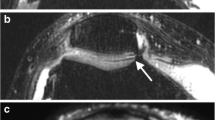Abstract
The purpose of this study was to compare the in-built body coil of the 3.0-Tesla (T) scanner with a dedicated surface coil of a 1.5 T system regarding knee imaging. We performed an intraindividual prospective clinical trial on 17 patients with knee pain using magnetic resonance imaging (MRI) at 1.5 and 3.0 T systems equipped with identical gradient systems. Proton-density-weighted turbo spin echo sequences with the same spatial resolution and comparable contrast parameters were used. A quantitative measurement of signal to noise ratio (SNR), relative contrast (RC) and contrast to noise ratio (CNR) between muscle and bone marrow was performed, followed by a qualitative assessment of anatomic/pathologic structures and the extent of artefacts. At 3.0 T, 30 lesions (91%) compared to 33 lesions at 1.5 T were detected. The SNR/CNR/RC were moderately reduced at 3.0 T versus 1.5 T (muscle 42 vs 47 and bone 83 vs 112/46 vs 69/0.33 vs 0.43). Motion artefacts from the pulsating popliteal artery were significantly increased at 3.0 T. A visible and measurable signal loss occurred at 3.0 T using the built-in body coil compared with the dedicated 1.5 T knee coil, but nearly all clinically important information could be obtained.




Similar content being viewed by others
References
Maubon AJ, Ferru JM, Berger V et al (1999) Effect of field strength on MR images: comparison of the same subject at 0.5, 1.0, and 1.5 T. Radiographics 19(4):1057–1067
Link TM, Majumdar S, Peterfy C et al (1998) High resolution MRI of small joints: impact of spatial resolution on diagnostic performance and SNR. Magn Reson Imaging 16(2):147–155
Schick F (2005) Whole-body MRI at high field: technical limits and clinical potential. Eur Radiol 15(5):946–959
Mundinger A, Ioannidou M, Dinkel E et al (1990) Inflammatory and traumatic lesions of the knee and ankle: comparison of 0.23 T and 2 T MRI. Radiat Med 8(6):211–214
Schroder RJ, Fischbach F, Unterhauser FN et al (2004) Value of various MR sequences using 1.5 and 3.0 Tesla in analyzing cartilaginous defects of the patella in an animal model. Rofo 176(11):1667–1675
Duewell SH, Ceckler TL, Ong K et al (1995) Musculoskeletal MR imaging at 4 T and at 1.5 T: comparison of relaxation times and image contrast. Radiology 196(2):551–555
Lu H, Clingman C, Golay X et al (2004) Determining the longitudinal relaxation time (T1) of blood at 3.0 Tesla. Magn Reson Med 52(3):679–682
de Bazelaire CM, Duhamel GD, Rofsky NM et al (2004) MR imaging relaxation times of abdominal and pelvic tissues measured in vivo at 3.0 T: preliminary results. Radiology 230(3):652–659
Peterson DM, Carruthers CE, Wolverton BL et al (1999) Application of a birdcage coil at 3 Tesla to imaging of the human knee using MRI. Magn Reson Med 42(2):215–221
Kornaat PR, Reeder SB, Koo S, Brittain JH, Yu H, Andriacchi TP, Gold GE (2005) MR imaging of articular cartilage at 1.5 T and 3.0 T: comparison of SPGR and SSFP sequences. Osteoarthritis Cartilage 13(4):338–344
Gold GE, Han E, Stainsby J, Wright G et al (2004) Musculoskeletal MRI at 3.0 T: relaxation times and image contrast. AJR Am J Roentgenol 183(2):343–351
Gold GE, Suh B, Sawyer-Glover A et al (2004) Musculoskeletal MRI at 3.0 T: initial clinical experience. AJR Am J Roentgenol 83(5):1479–1486
Author information
Authors and Affiliations
Corresponding author
Rights and permissions
About this article
Cite this article
Lutterbey, G., Behrends, K., Falkenhausen, M.V. et al. Is the body-coil at 3 Tesla feasible for the MRI evaluation of the painful knee? A comparative study. Eur Radiol 17, 503–508 (2007). https://doi.org/10.1007/s00330-006-0219-0
Received:
Revised:
Accepted:
Published:
Issue Date:
DOI: https://doi.org/10.1007/s00330-006-0219-0




